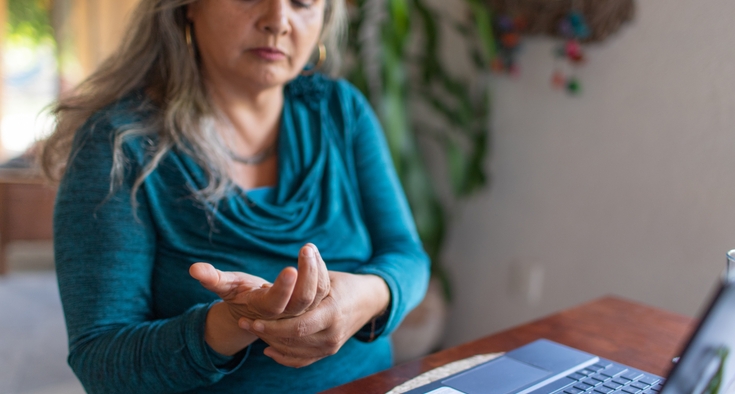Ever woken up with numb or tingling fingers? Experienced sore wrists after hours on a keyboard? Or simply struggled with everyday tasks?
These are often symptoms of tendonitis, a swelling of the tendons that can make simple tasks a pain to tackle. The condition occurs when a nerve in the wrist is pinched; it can be aggravated by repetitive physical activity or even swelling related to pregnancy.
Carpal tunnel syndrome can be debilitating at any age if not treated early and effectively.
“We see carpal tunnel syndrome affecting anyone from teenagers to people in their 90s,” said orthopedic hand and wrist surgeon Dr. Kyle Kokko, co-founder of the Hand Institute of Charleston – Mount Pleasant in Mount Pleasant, South Carolina. “The likelihood of getting tendonitis is much higher for very active patients.”
In addition to tendonitis, there is also tenosynovitis, which is inflammation around the tendon. This includes trigger finger and de Quervain’s, a condition that affects the thumb tendons. As with carpal tunnel syndrome, tenosynovitis is uncomfortable, but also curable – often without the need for surgery.
“We can do a simple injection during the patient's first visit to see if we can treat prior to discussing surgery,” Kokko said. “It’s pretty much a one-and-done for any given diagnosis.”
Kokko and Dr. Eric Angermeier founded the Hand Institute of Charleston. Here, Kokko explains his medical approach to carpal tunnel syndrome, as well as tenosynovitis conditions known as trigger finger and de Quervain’s.
Don't let hand and wrist pain keep you from living your best life.
How common is tendonitis in the hand and wrist?
About one in 10 people gets carpal tunnel syndrome, the most common form of tendonitis, in which the tendons swell within the tunnel of the palm and pinch the nerve.
Common symptoms include waking up with a hand asleep, and not being able to button a shirt or clasp earrings. Some people even have to shake out their hands after releasing their grip from the steering wheel for symptoms to resolve.
Is trigger finger less common than carpal tunnel syndrome?
Yes, but it’s the same idea. You have two tendons that go to each finger, and one tendon that goes to the thumb. As the tendons swell, they get stuck. People don't tend to sleep with a straight hand and can wake up with a finger bent at 90 degrees. By trying to straighten the finger, you're pulling that swollen tendon through the tunnel, and it gets stuck on the side closest to the fingertip. When that happens, there can be a palpable clicking or snapping of the finger.
Then there’s de Quervain’s tenosynovitis, which can be incredibly painful in the area from your thumbnail to the side of your wrist. New mothers get this all the time when they pick up their babies. While trigger finger and carpal tunnel are more of a nuisance in the beginning, de Quervain’s causes pain when shaking someone’s hand, buckling a belt or swinging a golf club.
What can we do to prevent tendonitis or tenosynovitis?
The best thing is to treat it early once you start having symptoms. If you're waking up with numbness and tingling, the first step is to buy a Velcro carpal tunnel brace, which keeps your wrist straight while you sleep. There are many varieties, but are all essentially the same. Insurance doesn't usually cover a brace, so we send patients to their local drugstores.
When do I need surgery for a wrist condition, and how invasive is the procedure?
Simply having a diagnosis of carpal tunnel, trigger finger or de Quervain’s doesn’t mean you're destined for surgery. We reserve surgery for when the injections or wrist braces don't work. If you treat it early –within the first three or four months – we can usually avoid surgery.
If you've got some numbness for a week, I don't get too concerned about that. But if it's going on for three weeks, that's where bracing can help. When we catch it early, my patients have a 75% chance of curing it with a simple injection.
With carpal tunnel, I do injections when the diagnosis is somewhat in question. If a patient complains of numbness and tingling in the thumb, pointer finger and middle finger, my physical exam may not reproduce those symptoms. So we'll do an injection to see if those symptoms resolve. Injections are not often the cure for carpal tunnel. But they often do work for trigger finger and de Quervain’s.
What happens during surgery for carpal tunnel, trigger finger or de Quervain’s?
The risk is very small. It takes less than 10 minutes to treat carpal tunnel, trigger finger or de Quervain’s. It's such a simple operation. The downside is minimal, with less than 1% chance of infection. You've got to give yourself some time to let the scar heal, so doing push-ups or planks or lifting heavy weights is off-limits for the first two weeks.
Patients can expect the pain to be gone after surgery, and then all you’re dealing with is minimal surgical discomfort. Hand surgeons do hundreds of these procedures every year. It's a common and rewarding surgery both for me and the patient.
Find expert, empathetic orthopedic care in the Carolinas










